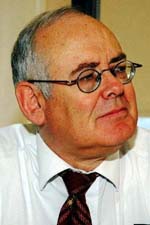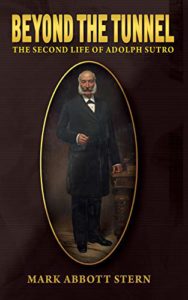BEYOND THE TUNNEL: The Second Life of Adolph Sutro, by Mark Abbott Stern. Mark Abbott Stern [Publisher], 2018. 322 pp. Notes, Bibliography, Index. Paper, $19.95.
By Abraham Hoffman

 LOS ANGELES — Any works dealing with mining activities in Nevada’s Comstock Lode will likely mention Sutro’s Tunnel, a project designed to solve the problem of excessive heat and water in the mines. Completed in 1878, the tunnel provided ventilation and aided miners who had experienced heat prostration. However, by the time the tunnel was completed, the heyday of the Comstock Lode was largely finished, and the tunnel never realized the huge profits Adolph Sutro had promised investors.
LOS ANGELES — Any works dealing with mining activities in Nevada’s Comstock Lode will likely mention Sutro’s Tunnel, a project designed to solve the problem of excessive heat and water in the mines. Completed in 1878, the tunnel provided ventilation and aided miners who had experienced heat prostration. However, by the time the tunnel was completed, the heyday of the Comstock Lode was largely finished, and the tunnel never realized the huge profits Adolph Sutro had promised investors.
Mark Abbott Stern’s biography covers the years spent on building the tunnel, as well as Sutro’s conflicts with mine owners who opposed it and the harassment of impatient investors who demanded to know when the tunnel would be completed and the profits to start rolling in. As suggested by the title of the book, Stern goes well beyond this episode that was only a part of Sutro’s career. It’s a warts and all biography, and Sutro had plenty of warts (metaphorically speaking).
Sutro was a man of contradictions. A secular Jew who seldom entered a synagogue or observed Jewish holidays, he generously supported Jewish (and non-Jewish) charities. Born in Prussia, Sutro made his home in San Francisco, though he enjoyed traveling and was often absent from home, traveling for extended periods to New York or Europe for business or pleasure. Married for 24 years and the father of nine children, he lived a bigamous life with a mistress and fathered two children with her. He could be affectionate yet obstinately firm, playing favorites with children and relatives. Sutro knew many famous people but had few friends. He abhorred politics but became embroiled in political issues as mayor of San Francisco. His hatred of the Southern Pacific’s notorious “Big Four” knew no bounds, especially regarding Collis P. Huntington.
Stern researched his subject thoroughly, utilizing the resources of the Bancroft Library, the Huntington Library, San Francisco Public Library, and records at the University of Nevada-Reno, Stanford University, and the Nevada Historical Society. He decided to number his footnotes consecutively, and there are 383 of them.
Beyond Sutro’s Tunnel, Stern describes Adolph’s business ventures, including establishing the town of Sutro, Nevada, his real estate investments that included much of San Francisco, and the expansive life style he maintained while scrambling for needed cash. Sutro dreamed big: the Sutro Baths featured a 400-foot swimming pool, seven pools in all (six of which were salt water at varying temperatures), an establishment that provided swim suits and changing rooms for patrons. He campaigned for a five-cent cable carfare, built a rail track to the baths, and fought against rival transit owners. Sutro’s defense of the workingman made him popular enough to get him elected mayor of San Francisco in 1894, but he hated the political infighting during his one term in office.
Stern provides a poignant note as an epitaph for Sutro who died in 1898. He cites Shelley’s “Ozymandias” poem, an apt reminder that fame and fortune are at best transitory after the death of even the most powerful of men. Sutro’s famous Cliff House Restaurant burned down twice, but exists in a third incarnation. Sutro’s Baths, however, no longer exists, nor does Sutro, Nevada. Stern succeeds in telling the story of a person remembered for one major achievement but who spent his life embroiled in controversies that in the end were beyond his or anyone else’s efforts to have his way.
One final note: curiously, Stern omitted any photographs of Sutro (other than on the book cover), not his family and relatives, his opponents, or the structures he built—the Tunnel, original Cliff House, or Baths, though images of these people and places can be easily seen on Google Images. This biography of Sutro is available via the Amazon website.
*
Abraham Hoffman teaches history at Los Angeles Valley College.